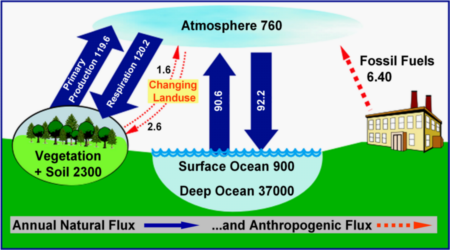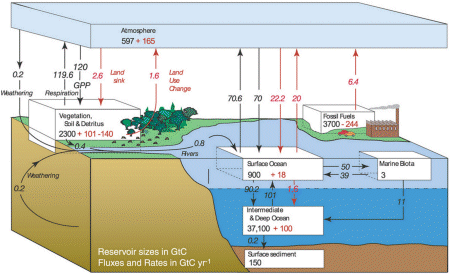Carbon Budgets and Fluxes
The large carbon reservoirs on earth and the flux between reservoirs are not precisely known. This applies particularly to the carbon content in vegetation, soil and sediments, and in the deep ocean, and also to the net land-to-atmosphere and ocean-to-atmosphere flux. Best known is the emission of fossil fuel and the atmospheric increase. Budgets and fluxes are shown below in two graphic illustrations with different complexity. The fossil fuel emission of 6.4±0.4 GtC per year minus fluxes caused by sinks on land and in the oceans result in a net increase of atmospheric carbon by 3.2±0.1 GtC per year.
Scenario
Obviously, the oceans are a relevant sink for carbon dioxide which is emitted to the atmosphere as a result of combustion of oil and gas. Although the biomass in the oceans is much smaller than on land, biological productivity is almost the same. Hence, carbon fixation is in the same order! No wonder that attempts are underway to increase biological productivity in the oceans, hoping that an essential part of the carbon fixed to phytoplankton particles will sink to the deep ocean. If so, then the carbon will be buried there! Since currents are very slow in the ocean, this part of the greenhouse gas will be removed from the climate system for thousands of years.
We become a geo-engineer!
This sounds like a good idea: fertilizing the oceans shall increase the burial of carbon in the deep sea, thus reducing greenhouse gas concentrations in the atmosphere!
Questions
- Which factors (e.g., light, temperature, salinity, transparency of the water, nutrients, ...) determine the biological productivity
of phytoplankton in the oceans? Which quantities are most important, which ones are less relevant? Are there essential differences
when compared with vegetation on land?
- Which factors (e.g., grazing by zooplankton and fish, bacterial attack, lack of nutrients, ...) determine the loss of phytoplankton?
- Assume that a phytoplankton bloom degrades because of circumstances mentioned in 2). Then the plankton particles start sinking slowly into the deep.
Which processes can lead to a decay of particles during sinking, so that they will not reach the sea floor?
- Please find arguments for the following hypotheses:
- Biological productivity in the ocean is limited by nutrients. Therefore, fertilization should lead to an increase of productivity and hence, to a higher uptake of carbon by phytoplankton which will be stored in the deep ocean
- Due to degradation processes which take place in the upper water column, increasing biological productivity will not result to an increase of carbon in the deep ocean. Instead, biomass will be rapidly re-mineralised. Organic carbon will be oxidised to carbon dioxide and subsequently released to the atmosphere.
Material needed
- The worksheet as printable rtf file
- SEOS tutorial Ocean Colour in the Coastal Zone, chapter 1, pages 3-6
- SEOS tutorial Ocean Currents, chapter 4, page 1
Background Information
- Lohafex provides new insights on plankton ecology - Only small amounts of atmospheric carbon dioxide fixed
- Fertilizing the Ocean with Iron
- Smetacek V & S W A Naqvi: The next generation of iron fertilization experiments in the Southern Ocean. Philosophical Transactions of the Royal Society A, 2008
- Biological Uptake in Oceans and Freshwater Reservoirs, and Geo-engineering. 4th Assessment Report of the Intergovernmental Panel on Climate Change
- Couplings Between Changes in the Climate System and Biogeochemistry. 4th Assessment Report of the Intergovernmental Panel on Climate Change


